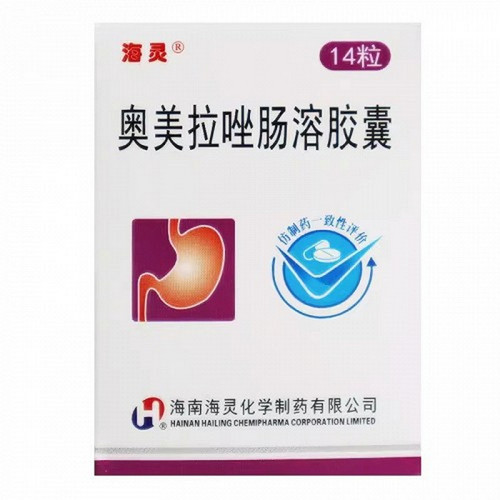Product Overview
[Drug Name]
Generic Name: Omeprazole Enteric-Coated Capsules
Trade Name: Shelan Omeprazole Enteric-Coated Capsules 20mg*14 Capsules
Pinyin Code: SheLan AoMeiLaZuoChangRongJiaoNang 20mg*14Li
[Main Ingredient]
The main ingredient is omeprazole. Chemical name: S-methoxy-2-(((4-methoxy-3,S-dimethyl-2-pyridyl)methyl)sulfinyl)-1H-benzimidazole.
[Properties]
This product contains white or off-white enteric-coated pellets or granules.
[Indications/Main Functions]
Indicated for gastric ulcers, duodenal ulcers, stress ulcers, reflux esophagitis, and Zollinger-Ellison syndrome (gastrinoma).
[Specifications]
20mg*14 Capsules
[Dosage and Administration]
For oral use; do not chew. 1. Peptic ulcer: Take 20 mg (1 tablet) once daily, 1-2 times daily. Take it in the morning or once in the morning and evening. The treatment course for gastric ulcer is usually 4-8 weeks. 2. Reflux esophagitis: Take 20-60 mg (1-3 tablets) once daily, 1-2 times daily. Take it in the morning or once in the morning and evening. The treatment course is usually 4-8 weeks. 3. Zollinger-Ellison syndrome: Take 60 mg (3 tablets) once daily. The total daily dose can be adjusted to 20-120 mg (1-6 tablets) depending on the condition. If the total daily dose exceeds 80 mg (4 tablets), take it in two doses.
[Adverse Reactions]
Common adverse reactions of this product include headache, diarrhea, nausea, vomiting, constipation, abdominal pain, and bloating. Occasionally, dizziness, drowsiness, fatigue, sleep disturbances, paresthesia, rash, itching, urticaria, and abnormal liver function tests may occur. Rarely, hyperhidrosis, peripheral angioedema, and hyponatremia; angioedema, fever, and anaphylactic shock; leukopenia, thrombocytopenia, agranulocytosis, and pancytopenia; reversible confusion, irritability, depressive attacks, and hallucinations; gynecomastia; dry mouth, dysgeusia, stomatitis, candidiasis; alopecia (allergy, erythema multiforme); hepatic encephalopathy (in patients with preexisting severe liver disease); icteric or non-icteric hepatitis; liver failure; bronchospasm; arthralgia, myalgia, and muscle fatigue; interstitial nephritis; blurred vision.
[Contraindications]
This product is contraindicated in patients with hypersensitivity to this product, severe renal insufficiency, and infants.
[Drug Interactions]
1. Avoid concomitant use with oral imidazole antifungals such as ketoconazole, itraconazole, miconazole, and fluconazole. 2. Concomitant use of omeprazole and clarithromycin may increase the incidence of central nervous system (primarily headache) and gastrointestinal adverse reactions. 3. Avoid concomitant use with diazepam (Valium), phenytoin, warfarin, nifedipine, digoxin, cisapride, quinidine, caffeine, and theophylline. 4. Concomitant use with other medications may cause drug interactions. Please consult a physician or pharmacist for details.
[Precautions]
1. Do not use for more than 7 days. If symptoms do not improve or disappear, consult a physician or pharmacist. 2. Do not use again within 2 months. If symptoms recur, consult a physician immediately. 3. Do not use this product in the following situations: difficulty or pain swallowing; vomiting blood; or bloody or black stools. These may be signs of a serious condition; consult a physician. 4. Patients with impaired liver function or abnormal blood counts should use this product under the guidance of a physician. 5. If heartburn persists or worsens, discontinue use and seek medical attention. 6. Children should only use this product under the guidance of a physician. 7. Use with caution during pregnancy or lactation. 8. In case of overdose or serious adverse reactions, consult a physician immediately. 9. Do not use if allergic to this product. Use with caution if allergic. 10. Do not use if the properties of this product change. 11. Keep out of reach of children. 12. Children must be supervised by an adult before use. 13. If you are taking other medications, consult a physician or pharmacist before use.
[Children's Use]
Follow your physician's instructions.
[Elderly Use]
This product has not been tested and there are no reliable references.
[Overdose]
Unknown.
[Pharmacology and Toxicology]
Proton pump inhibitor. This product is a fat-soluble weakly alkaline drug that is easily concentrated in an acidic environment. Therefore, after oral administration, it can be specifically distributed in the secretory tubules of the gastric mucosal parietal cells and converted into the active form of sulfenamide in this high-acid environment. It then irreversibly combines with the sulfhydryl group of the H+, K+-ATPase (also known as the proton pump) in the secretory membrane of the parietal cells through a disulfide bond to form a complex of sulfenamide and the proton pump, thereby inhibiting the activity of the enzyme and blocking the final step of gastric acid secretion. Therefore, this product has a strong and lasting inhibitory effect on gastric acid secretion caused by various reasons.








